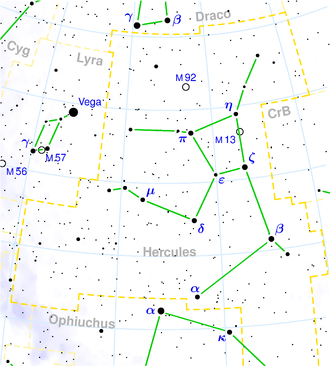NGC 6177
| Galaxy NGC 6177 |
|
|---|---|

|
|
| SDSS recording | |
| AladinLite | |
| Constellation | Hercules |
|
Position equinox : J2000.0 , epoch : J2000.0 |
|
| Right ascension | 16 h 30 m 38.9 s |
| declination | + 35 ° 03 ′ 23 ″ |
| Appearance | |
| Morphological type | (R ') SB (s) b |
| Brightness (visual) | 13.7 mag |
| Brightness (B-band) | 14.5 mag |
| Angular expansion | 1.7 ′ × 1.2 ′ |
| Position angle | 10 ° |
| Surface brightness | 14.3 mag / arcmin² |
| Physical data | |
| Redshift | 0.031048 ± 0.000030 |
| Radial velocity | (9308 ± 9) km / s |
|
Stroke distance v rad / H 0 |
(423 ± 30) · 10 6 ly (129.6 ± 9.1) Mpc |
| history | |
| discovery | Wilhelm Herschel |
| Discovery date | May 28, 1791 |
| Catalog names | |
| NGC 6177 • UGC 10428 • PGC 58390 • CGCG 196-072 • MCG + 06-36-49 • IRAS F16288 + 3509 • KUG 1628 + 351 • 2MASX J16303889 + 3503234 • GC 4215 • H III 890 • h 1964 • | |
NGC 6177 is a 13.7 mag light barred spiral galaxy of the Hubble type SBb in the constellation Hercules. It is an estimated 423 million light years away from the Milky Way and has a diameter of about 210,000 ly. In the same area of the sky there are u. a. the galaxies NGC 6179 and NGC 6185 .
The object was discovered on May 28, 1791 by Wilhelm Herschel with an 18.7-inch reflector telescope, who described it as "vF, pL, lE, lbM".
